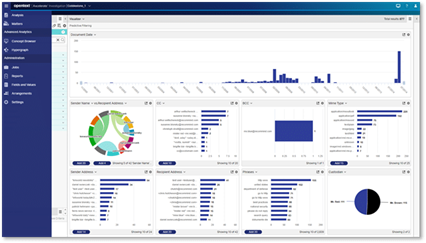Rachel: Can you tell me a bit about OpenText Legal Tech, and what the acquisitions of Recommind and Catalyst bring to the table?
Jennifer: In 2017, OpenText, which is a $3.3 billion publicly traded company founded in 1991, made a series of strategic acquisitions in e-discovery to augment its leadership in information management. The first acquisition was Recommind, the leader in predictive coding, where I led Axcelerate product management. The second acquisition, two years later, was Catalyst, known for its Insight E-discovery platform and Insight Predict continuous active learning tool.
Both companies bring substantial market leadership and experience in technology-assisted review (TAR), also known as predictive coding, to our clients, as well as comprehensive start-to-finish e-discovery. Axcelerate is available globally and is used by law firms, corporations and government agencies of all sizes for litigation, investigations and regulatory compliance. Insight is available in North America and is used by many of the largest law firms and corporations for the same, including serial repetitive litigation.
The Legal Tech product portfolio includes Axcelerate, Insight and Insight Predict (TAR based on continuous active learning), Decisiv (enterprise search and knowledge management software from Recommind), Legal Hold (cloud-based legal hold software from Catalyst, formerly known as TotalDiscovery), and the eDOCS legal content management platform (formerly Hummingbird).
What innovations has OpenText brought to market since the acquisitions of Recommind and Catalyst?
A lot. We introduce new enhancements and features across all products on a quarterly release schedule. We’re always looking at better ways that global corporations and their law firms can meet the demands of modern litigation, investigations and regulatory compliance matters--faster and with better quality and at lower cost.
We’re continually looking at how our clients can handle the three “Vs”: More ESI Volume, Data Velocity and Variety. We’re also well attuned to forward-thinking features that will help clients meet regulatory mandates, such as data privacy rules and DSAR responses, data breaches and more civil litigation and investigations with tight timelines.
An example of a significant upcoming enhancement for Insight is the pending release of Best Passage Highlighting using Insight Predict. This unique capability brings transparency to Predict TAR processes by shining a light on the key passage within a document surfaced by Predict’s TAR algorithm so reviewers can easily see why a particular document is likely to be relevant.
From your perspective, how is Axcelerate unique in the e-discovery market?
Jennifer: There are several areas in which Axcelerate brings distinct and differentiated value to help our clients tackle new challenges.
End-to-end integrated capabilities
First, Axcelerate is truly an end-to-end integrated e-discovery platform that’s engineered to fuel efficiency and cut costs at each stage of the EDRM, from collection through production. Many of our corporate clients assessed their technology strategy and moved away from eDiscovery point solutions and numerous service providers to take advantage of the comprehensive and integrated end-to-end capabilities of Axcelerate, which is fully supported by expert services, project management and the OpenText support team.
Axcelerate offers more than 45 connectors to data sources. We’ve expanded connectors (including Google cloud storage, Teams, Slack and Cellebrite) so that legal teams are in control of data collection and can collect expansively but precisely to constrain the volume of data for eyes-on review.
Our clients can then move to fast and effective processing and culling, using the richest set of smart filters in the industry, automated phrase analysis and concepts and predictive filters that “find similar” data fast to quickly reduce and refine review sets. From there, TAR, Predictive Search and advanced analytics can be applied to quickly find relevant data and redact in bulk or by document. Axcelerate’s production wizard easily executes discovery sets with automated QC to assure productions are correct and that redactions are complete.
Powerful front-ended analytics
Second, our development team has made Axcelerate’s powerful analytics tools available up-front in Axcelerate Investigation to help conduct early case assessment and narrow data sets without (or prior to) conducting a full TAR review. Axcelerate Investigation can be a standalone platform and is also part of the full Axcelerate solution. We’ve also integrated text analytics from OpenText™ Magellan™ to provide additional windows of insight into the context and meaning of data. And, of course, Axcelerate’s TAR capabilities are very robust.
Third, Axcelerate can be deployed in different ways, depending on what fits best with your IT environment, e-discovery needs, budget and resources. We have clients who have it installed fully on-premises, some in a private AWS cloud, and others on a cloud-based OnDemand model. We also offer a hybrid on-premises and cloud model for clients who want to keep some data on-premises for reasons such as data security or data privacy needs, as well as a mobile air-gapped solution when data can’t be moved at all off a client’s premise.
What's new with Axcelerate?
Over the past year, we’ve continued to add connectors, streamlined data ingestion and improved review management processes with review in context and review batch grouping. We have also substantially enhanced Axcelerate’s reporting capabilities for better project management. New or revamped reports include review progress reporting, reviewer productivity reporting and overturn reporting.
On the analytics side, we introduced Visualizer. These powerful visual analytics and heat maps surface patterns within review data and detect anomalies, opening entirely new opportunities for seeing the context and meaning of data by displaying how any two non-binary analytics viewpoints compare to each other. For example, file size and MIME type can be mapped against each other for additional detail on the structure of data sets and custodians can be mapped against fact vs. opinion analysis to see who is prone to unsubstantiated assertions.

Axcelerate also introduced the ability to view, redact and produce Microsoft Excel files in native format.
Diving more into the Axcelerate platform, how does it address new communication forms, such as chat?
New communication channels always add complexity to the e-discovery review process. Employee use of communication channels such as Microsoft® Teams and Slack™, for example, accelerated with an increasingly remote workforce. Review teams now need to synthesize complex chat threads in addition to email and other forms of electronic communication—but piecing together the facts from amongst disparate sources is often unwieldly.
Axcelerate tames chat review with efficiency and automation by making it easy to ingest chat data with a connector and pre-configured parser for Microsoft Teams, a pre-configured parser for Slack, and a generic parser for all other forms of chat data. In Axcelerate Cloud Edition (CE) 21.4, our latest release, we’ve built on chat review functionality, offering better ways to review and understand business communications that go far beyond email threads.
In addition to intuitively displaying chat conversations, Axcelerate allows reviewers to break down chat histories by date to narrow the volume of chat data that requires review. They can also open the chat participant panel to easily view all the participants involved in a chat thread. Furthermore, the enhancement improves review efficiency by allowing reviewers to preview chat attachments so that they can quickly assess which attachments warrant closer review and which can be skipped.
Data privacy compliance, including the GDPR and CCPA, is also a relatively new challenge many organizations are facing. Can you talk about Axcelerate’s capabilities in these areas?
It’s certainly an increasing area of focus for our clients. E-discovery platforms must have extensive data identification and protection tools to avoid exposing personal data (to opposing counsel and other parties), so e-discovery workflows are naturally tuned for other data privacy use cases.
For subject rights requests, including DSARs, Axcelerate is ideally suited for requests that involve large volumes of diverse data such as requests coming from staff. Axcelerate’s analytics tools and review workflows cut the cost of fulfilling requests to a fraction of more manual processes. Axcelerate’s automated detection of names also assists by making it easier to redact third-party data so as not to infringe on their privacy while honoring the rights of the requestor.
Axcelerate is also very capable at handling data breach response investigations. In addition to having the tools to find the pattern-based sensitive data that was breached, Axcelerate’s analytics and review capabilities can also discover and define the confidential business information (CBI) such as contracts and client lists that may have been breached for a full assessment of the impact to organizations.
Axcelerate CE 21.4 introduces Regular Expression (RegEx) Search Enrichment (or pattern search) to detect and protect personal and confidential information. RegEx Search Enrichment protects data privacy and speeds review by auto detecting PII, PCI and PHI and capturing the identified values in Smart Filters. In this latest release, Axcelerate’s pre-configured PII pattern recognition includes sensitive information such as SSNs, credit card numbers, email addresses, taxpayer IDs, passport numbers, Medicare numbers and birthdates. These same pre-configured patterns were also added to the bulk redaction wizard.
Can you talk more about the OpenText services you’ve mentioned?
We offer supporting services across the EDRM, including collections, digital forensics, managed document review, TAR consulting and more, all designed to optimize the use of Axcelerate and Insight. I’ll focus on just a few of the newer ones.
In many e-discovery or investigation review scenarios, the goals may differ depending on the type of investigation, whether it’s an outbound production, an inbound review, a third-party subpoena or a regulatory request. So, a straight TAR process may not always be the most efficient or cost-effective.
Our professionals are expert at being dropped into what may seem like impossible situations in terms of timelines and budget. They leverage our technological tools and proprietary review tactics to hit extremely tight deadlines and save costs by aggressively but defensibly reducing review volumes and quickly finding the facts.
Last year, we introduced Recon Investigations, a revolutionary new way to uncover facts in ECA or an investigation with unprecedented speed, accuracy and cost-savings. Unlike a traditional review, where you might find the 50 to 100 documents that matter after having conducted a full review and spent millions of dollars over several months, our experts in unstructured data interrogation will find those same documents before a full document review even begins – often in just two or three weeks – giving clients the documents that can better inform case strategy and downstream spend decisions.
There are a lot of other review situations as well, such as third-party subpoenas and HSR second requests, to name a few—in which a full-blown TAR review may not be the most effective way to meet a client’s goals. For example, in a third-party subpoena, we’ll use investigative and analytic techniques to quickly find groups of documents with similar characters that are amenable to bulk coding leading to production. It’s an optimal approach for meeting legal obligations within time and budget constraints.
This investigative review approach can also be used in conjunction with a managed review to assess inbound productions from opposing parties to quickly find key evidence, kickstart the TAR process, bifurcate a review (apply more traditional TAR to some documents while simultaneously bulk coding a subset of documents), or complement QC to ensure alignment to requirements.
We also launched a Breach Response Analysis & Reporting service to help clients mitigate risk by quickly identifying breached data, including PII, PCI, PHI and CBI, along with who was breached. This service builds upon our investigative expertise plus the power of our e-discovery platforms, whether Insight or Axcelerate, for automated pattern detection, entity identification and standardization, and the discovery and review of CBI.
Can you provide some examples of how clients benefit from Axcelerate?
Let me highlight how a few of our clients use Axcelerate.
Switch
Axcelerate has helped Switch, a global technology infrastructure company that designs, builds and operates data centers, to deliver results 50 percent faster than the providers they used previously through a combination of our technology and managed services. The flexibility of Axcelerate’s deployment options delivered a hybrid solution that further met Switch’s need for absolute security of data, with some components on-premises and some in the cloud. Saving money was also important to Switch, and they materially--and almost immediately reduced costs.
Serious Fraud Office
The Serious Fraud Office, or SFO, is another example that comes to mind. They’re a branch of the UK criminal justice system dedicated to investigating and prosecuting large-scale cases of fraud, bribery and corruption. The volume of documents, and sheer number of cases, were historically a problem for the SFO. Axcelerate easily handles their high data volumes and the SFO investigators appreciate how quickly they can now find the important documents that they need to proceed with their cases.
Pillsbury
Pillsbury, an AmLaw 100 law firm, uses Axcelerate to provide a differentiated and more efficient e-discovery process for their clients. They’ve standardized discovery processes across projects in a consolidated platform and have reduced costs by processing and hosting data in a self-controlled cloud environment. They have also told us that the ability Axcelerate gives them to quickly get to the facts in their cases has allowed them to form the narrative and merits of their cases earlier, giving them strategic and settlement advantages.
Phillips Lytle
Phillips Lytle also comes to mind. The firm has repeatedly outperformed client expectations and hit new deadlines by using Axcelerate’s TAR and analytics in conjunction with OpenText services to help develop and implement many kinds of review workflows, from linear to continuous prioritization to expedited production. Further, Phillips Lyle has been able to minimize staffing obligations on review projects that would have otherwise required a large team of review attorneys working around the clock, thus saving their clients substantial time and money. Finally, the firm has reduced infrastructure costs, can scale capacity and pay only for what they need by deploying Axcelerate in the cloud.
What’s next on the horizon for Axcelerate?
We will continue to enhance the breadth of connectors, the visualization and reporting tools within Axcelerate along with everything else required to help clients run fast, easy and cost-effective e-discovery.
In the near future, Predict – the continuous active learning algorithm in Insight – will be integrated into Axcelerate. Predict continuously learns what’s important to the matter and becomes smarter as the review progresses, and its companion contextual diversity algorithm ensures that no pockets of data are left unexplored. We have a dedicated team devoted to advancing our machine learning efforts across our product portfolio and are excited to bring this advancement to Axcelerate customers.
I’m excited by what the future of Axcelerate holds.
Published April 7, 2022.





